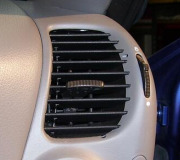The clue here is "After 5 to 10mins driving". Intermittent problems are always hard to find because you can only troubleshoot them while the problem is acting up. Otherwise, everything is working properly so there are no defective parts to find.
I'm not sure how you tested the alternator, but if it is the cause of the problem, by your own observation, it works fine for a few minutes so it will also on a test bench. This is the classic symptom of worn brushes in the alternator, and 177,000 miles is about the time they're ready to stop being brushes! The assembly is fairly easy to replace, but most people just replace the whole alternator.
There are other potential causes, but lets start with the most common. There are two small wires plugged into the back of the unit. They will only have voltage on them for one to two seconds after you turn on the ignition switch, then again when the engine computer sees engine rotation, (cranking or running). Watch out for the spinning belt. You'll have to reach around to the back and measure the voltages on those two wires while the engine is running. One of them will have full battery voltage. If neither of them do, you have a different, uncommon problem. You want the other wire that will normally have between about 4 - 11 volts. If you find exactly the same voltage on both wires, there is a break in the wire going to the voltage regulator in the engine computer. Check for corroded pins in the connectors in the area. If you do find between 4 - 11 volts, you need to monitor the voltage after driving a while. Use a clip lead, (alligator clip) on that wire, then run a temporary wire into the car where you can hook it to a test light or voltmeter. It's normal for a test light to flicker but I'm expecting it will go out after a few minutes. That's when the other problems will start acting up.
If the first wire still has battery voltage, and the second one has 0 volts, the brushes are worn. If you have access the the assembly, (about 15 bucks), it is possible to replace it without removing the alternator from the engine, but it might be easier to take it off so you can see what you're doing.
Caradiodoc
SPONSORED LINKS
Sunday, February 14th, 2010 AT 4:42 AM



